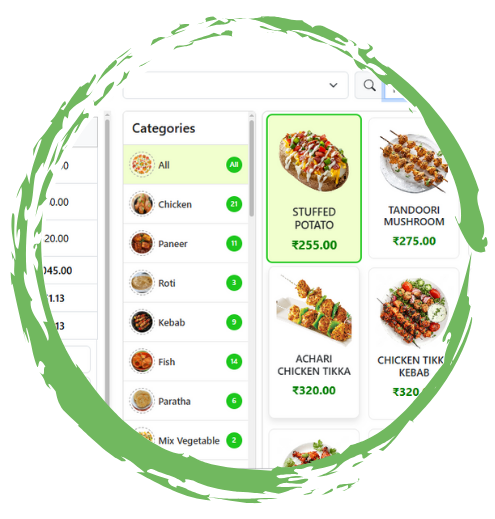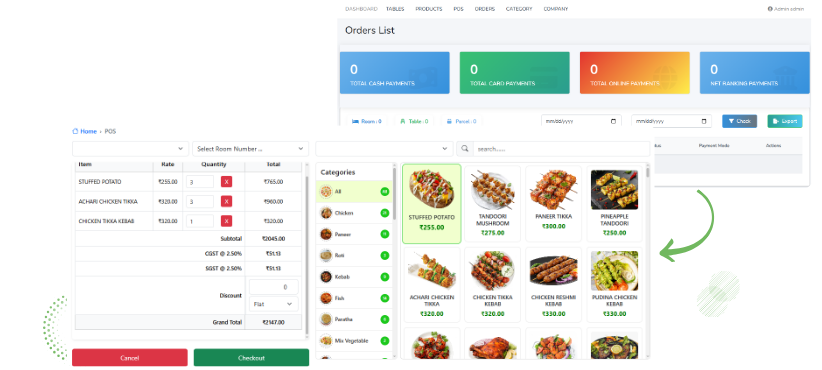Welcome To Technext Technosoft
Restaurant Management System

A Complete Overview Of a Powerful Restaurant Management System
A Restaurant Management System is a powerful tool that assists in automating as well as simplifying the day-to-day operations of your restaurant. This system improves the user experience, provides efficient performance, and reduces the risk of errors by offering various solutions such as managing reservations, processing orders, and tracking inventory.
Technext Technosoft Pvt. Ltd. drives operational and growth success by helping different types of restaurants in controlling the power of a Restaurant Management System. We design this solution seamlessly and efficiently for you, whether you are a business owner of a small café or a multi-branch restaurant chain, to meet your requirements with ease and precision.

Restaurant Management System: Top Features You Get
Run your restaurant more effectively and grow faster with our seamless Restaurant Management System. It is precisely designed to improve user experiences, smooth operations, and upgrade overall efficiency with smart, user-friendly features, by making restaurant management easier, faster, and more profitable than ever before.
Explore the top features you get from us:
Effortless Table Reservations
Table Reservation System assists customers in an advanced table booking system, reducing wait times, as well as enhancing customer satisfaction.
Digital Menu & Ordering
The Restaurant Management System helps restaurants offer fast and efficient service. They improve the dining experience with their in-built digital menu and ordering system.
POS Integration for Real-Time Transactions
Point of Sale (POS) Integration links your sales with the backend. It provides you with real-time financials and performance insights.
Smart Reservation Calendar
Restaurant Management System helps you inspect and optimize table availability with a smart reservation calendar across days and hours.
Daily Sales Summary Reporting
With the help of a Daily Sales Summary, get transparent insights that assist in tracking revenue, expenses, and profits in a single snapshot.
Event & Party Booking Module
The Restaurant Management System consists of an event booking module that allows users to reserve individual spaces for private events flawlessly.
QR Code Menu Access
QR code menu access allows diners to scan and browse their menu using QR codes. This makes the experience faster, more transparent than earlier.
Manage Multiple Branches with Ease
Multi-Branch Management allows users to control various locations from a single dashboard, guaranteeing transparency in policies.
Staff Roster & Control Panel
Staff Management in the Restaurant Management System helps to track hours, assign shifts, and assess performance efficiently.
Inventory Monitoring & Control
Inventory Monitoring & Control helps to avoid stockouts and reduce waste by staying in control of ingredients and supplies.
Waste Tracking & Reduction Tools
The Restaurant Management System provides Waste Management tools to assist you in monitoring, recording, and minimizing unwanted food and resource loss.

Get a Customized Restaurant Management System Here!
Technext Technosoft Pvt. Ltd. helps different types of restaurants scale with our reliable Restaurant Management System. Our system streamlines operations as well as uplifts user satisfaction and staff productivity for all over business growth.
Despite these features, we offer fully customized services to fulfil the specific requirements of individuals. So, whether anyone is seeking a full-featured Restaurant Management System or a specific module, our team is here to deliver customized solutions that fit your vision.
Request for a Demo

We Provide All Kind Of Restaurant Automation System
Get a Quote Now !
Frequently Asked Questions
A restaurant management system is an extensive software solution designed to guarantee a restaurant's smooth operations. It incorporates various functions such as inventory tracking, table reservations, order management, employee scheduling, customer relationship management, and billing into one universal platform. This system helps restaurant managers and owners decrease the risk of human errors, boost their efficiency, and monitor performance. It helps restaurant staff deliver excellent customer service by automating routine tasks. This system also provides indispensable insights and data from forecasting sales to planning the menu, which supports a better decision-making process. The restaurant management system guarantees effective and flawless coordination across all departments, whether in a large dining space or a small café. It is a vital part in decreasing the costs of operation, enhancing customer satisfaction, and increasing profitability. It is essential to implement to maintain consistency in managing all functions, which helps in long-term business success in today’s competitive food industry.
The core features of a restaurant management system consist of order management, where restaurant staff can track and take orders flawlessly. This system also provides a table management facility that helps assign and manage seating arrangements. Processing payment and billing is another important feature that allows customers to pay via different methods. People can track their orders and know about which ingredients are being used, as well as track the status of low stock. Customer management offers customized service as well as safely stores customer details in it. Staff management helps staff manage their attendance, schedules, and performance data. Analytics and reporting both give popular items, insights into sales, and customer behavior. This system also supports online delivery tracking and ordering. All these features enhance the quality of services, save more on money and time, and reduce errors by working together. The best restaurant management system helps businesses work smoothly and enhances the overall experience for both customers and staff.
A restaurant Point Of Sale (POS) system assists in managing sales, orders, and payments in a restaurant. On the placement of an order by a customer, the order is entered into the system by the staff with the help of a tablet or computer. After that, the kitchen staff receives the order through the system and starts preparing. Once the food is prepared, the server delivers it to the customer. Soon after that, the system helps restaurant staff to generate the bill and accepts money through various types of payment options such as cash, card, or digital wallets. The Point Of Sale (POS) system also tracks daily sales, customer data, and inventory. With the help of this information, managers can enhance restaurant services and make better decisions. It also saves time and money, properly organizes everything, as well as reduces the risk of errors. Overall, a restaurant's Point Of Sale (POS) system helps the restaurant management system run faster, smoother, and more efficiently for both customers and staff.
Utilizing a restaurant management system brings various advantages to the daily operations of a restaurant. It makes every task easier, such as taking orders, processing bills, managing reservation tables, as well as handling inventory. This system saves valuable time and money for the users and reduces the risk of making mistakes, keeping everything in one place. The system helps restaurant owners to make smart decisions, providing clear reports on customer choices, stock, as well as sales. Customers receive more accurate and quicker service as well, and restaurant staff members work more efficiently by managing every task smoothly. This helps to enhance communication between the front staff and kitchen staff. It tracks inventory and sends an alert when items are running low, which helps reduce waste. It also supports online orders and payments, which are important for modern customers. However, a restaurant management system helps restaurants become more successful and organized.
Restaurant management system implementation faces various kinds of challenges. Resistance towards change is one of the important challenges faced by restaurant staff. Now, coming to the next challenge. System set-up is another challenge of the system, which consists of both the hardware and the software. Some restaurants suffer from different types of technical problems, such as a lack of support or having poor internet connection. Data security is another crucial concern for the staff, as restaurants are required to protect business and customer information. Opting for the right restaurant management system that fits the requirements and the size of the restaurant can be difficult. Integration may not always be smooth with tools such as online ordering platforms or payment systems. Finally, the system needs routine updates and maintenance to run and function smoothly. Adapt to advanced technology by overcoming challenges such as good support, proper planning, and a willingness.

Read more

